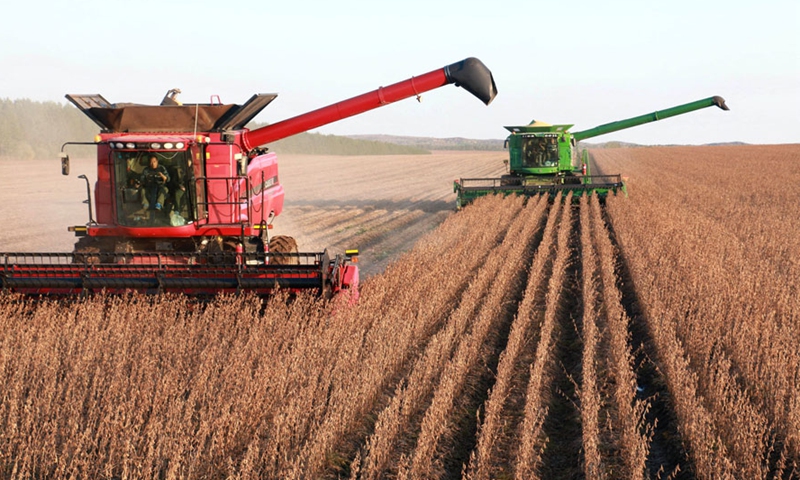China vows measures to hike soybean output in bid to bolster food security

Soybeans are harvested in Heilongjiang province. File photo: Xinhua
China will take multiple measures this year to increase the output of soybeans and other oilseeds, such as improving subsidies for farmers, actively guiding farmers in Northeast China - a main production base - to plant more soybeans, and promoting soybean-corn intercropping technology, agricultural officials said on Wednesday, after this year's No.1 central document prioritized ensuring food security.
With a self-sufficiency rate of less than 20 percent, soybeans are one of the few grains for which China relies heavily on imports. Industry observers said that it's urgent for the world's second-largest economy to tackle this persisting issue, both to safeguard food security and address vulnerabilities at a time when the global pandemic, fractured global supply chains and rising geopolitical tensions are weighing on China's trade ties.
China will strive to make edible oil bottles "filled up with as much homegrown oil as possible" and the country is determined to address structural issues and beef up the domestic production of soybeans and oilseeds, Minister of Agriculture and Rural Affairs Tang Renjian said during a press briefing of the State Council, China's cabinet, on Wednesday, stressing that the country aims for "a significant rise" in self-sufficiency of soybeans and other oilseeds within five to 10 years.
The press briefing was focused on the No.1 central document released on Tuesday night. The annual agricultural and rural policy blueprint includes detailed efforts to expand the output of soybeans and other oilseeds, which industry insiders said would be key to "firmly holding the bottom line of guaranteeing China's grain security," one of the main goals of the policy document.
According to Tang, authorities will improve subsidies for soybean and corn producers, and support the proper rotation between soybeans and corn in Northeast China to encourage farmers to plant more soybeans in spring sowing.
China will also encourage farmers in Northeast China to plant soybeans on arable land that's unsuitable for rice.
Another measure is to actively facilitate soybean-corn intercropping, which refers to planting two lines of corn and four lines of soybeans on farmland that ensures both stable corn and soybean output.
This technology to date has been tried on 7 million mu (466,700 hectares) of farmland, and Tang said it will be further applied this year in suitable areas of the Huang-Huai-Hai region, Southwest and Northwest China. Accompanying services in seeds, machinery and financing will be strengthened.
Jiao Shanwei, editor-in-chief of industry news website cngrain.com, told the Global Times on Wednesday that "a critical moment has come for Chinese authorities to increase financial and technological aid, otherwise the market will deviate further and endanger China's food security."
In 2021, China's total soybean planting area was 126 million mu, down 22 million mu from 2020, data from the National Bureau of Statistics showed.
Jiao said that the decline was mostly due to farmers' preference for corn, which is more lucrative and has a high level of mechanization. Also, the market price of soybeans fluctuated due to foreign players' pricing power, further affecting Chinese farmers' willingness.
Li Guoxiang, a research fellow at the Chinese Academy of Social Sciences, told the Global Times on Wednesday that given soaring global agricultural prices, it is necessary for China to reduce reliance on soybean imports, which account for over 80 percent of the supply.
On the one hand, the COVID-19 pandemic has shattered global supply chains, posing potential issues of supply suspensions that could last for months. On the other hand, as geopolitical tensions heat up, China's high demand for soybeans may risk handing external forces a bargaining chip that could be used against China, analysts said.
China is the world's largest soybean importer and consumer. In 2021, China imported more than 90 million tons of soybeans, and the volume in 2020 was over 100 million tons, customs data showed. Major sources of imports are the US, Brazil and Argentina.
Observers also suggested that China should increase research and development input in soybean seeding and planting.
"In terms of soybean yield per mu, China is 100 grams lower than the US," so technological breakthroughs can help, Jiao said.
It is expected that the soybean planting area in China will reach 160 million mu, with an output of 23 million tons, according to the 14th Five-year plan (2021-25) issued by the Ministry of Agriculture and Rural Affairs.
Photos
Related Stories
Copyright © 2022 People's Daily Online. All Rights Reserved.










